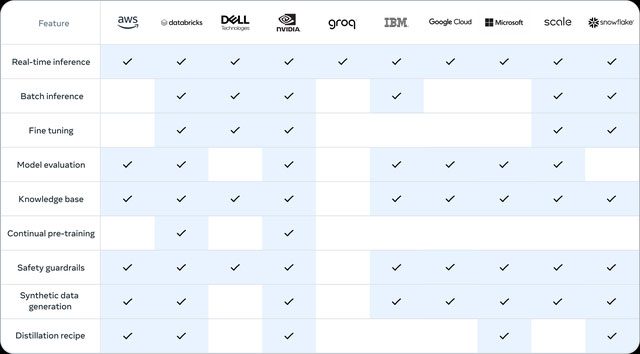Despite spending billions of USD to build and develop this model, Meta is now releasing its AI model for free to the world.
In April, Meta revealed that they were developing their first open-source AI model with performance comparable to the best private models from companies like OpenAI. That model has now been launched.
Meta is releasing Llama 3.1, the largest open-source AI model to date, which the company claims surpasses GPT-4o and Claude 3.5 Sonnet from Anthropic on several evaluation metrics. They are also expanding the Meta AI assistant based on Llama to more countries and languages while adding a feature that can generate images based on a specific person’s appearance. CEO Mark Zuckerberg is currently predicting that Meta AI will become the most widely used assistant by the end of this year, surpassing ChatGPT.

Meta is releasing Llama 3.1 – the largest open-source AI model to date.
Compared to the smaller Llama 3 models launched a few months ago, Llama 3.1 is significantly more complex. The largest version has 405 billion parameters and was trained using over 16,000 extremely expensive Nvidia H100 GPUs. While Meta has not disclosed the development cost of Llama 3.1, based on the costs of the Nvidia chips alone, it can be estimated to reach hundreds of millions of USD.
So, with such costs, why does Meta continue to offer Llama for free with a license that only requires approval from companies with hundreds of millions of users?
In a letter posted on Meta’s company blog, Zuckerberg argues that open-source AI models will surpass – and are improving faster than – proprietary models, similar to how Linux became the open-source operating system powering most phones, servers, and devices today.
He compares Meta’s investment in open-source AI to the previous Open Compute Project, which he says helped the company “save billions of USD” by having outside companies like HP improve and standardize Meta’s data center design while the company was building its own capabilities. Looking to the future, he expects similar momentum to occur with AI, writing, “I believe that the release of Llama 3.1 will be a turning point in the industry, as most developers will begin to primarily use open-source.”

Partners helping Meta develop and refine Llama-3
To help bring Llama 3.1 to the world, Meta is collaborating with over two dozen companies, including Microsoft, Amazon, Google, Nvidia, and Databricks, to assist developers in deploying their own versions. Meta claims that the operational cost of Llama 3.1 in production is only about half that of OpenAI’s GPT-4o. They are releasing a weighted model so companies can train it on custom data and adjust it as desired.
It is no surprise that Meta has not disclosed much about the data they used to train Llama 3.1. Those working in AI companies say they do not reveal this information as it is proprietary, while critics argue that it is a tactic to delay the inevitable wave of upcoming copyright lawsuits.
What Meta will say is that they used synthetic data, or data generated by a model rather than humans, to produce the 405 billion parameter version of Llama 3.1, improving upon the smaller 70 billion and 8 billion versions. Ahmad Al-Dahle, Vice President of Generative AI at Meta, predicts that Llama 3.1 will be favored by developers as “a teacher for smaller models that can then be deployed in a more cost-effective manner.”

Comparison chart between Llama 3.1 and other AI models, with Gemini excluded as Meta could not use Google’s API to recreate comparative results.
For the first time, Meta’s red teaming for Llama 3.1 includes searching for potential use cases in cybersecurity and bioengineering. Another reason for more thorough testing of the model is what Meta describes as emerging “agent” behaviors.
According to Al-Dahle, one advantage of the new model is its ability to integrate with search engine APIs to “retrieve information from the internet based on a complex query and call multiple tools in succession to complete your task.” One example he provided is asking the model to chart the number of homes sold in the U.S. over the past five years. “It can perform a [web] search for you, generate Python code, and execute it.”
Llama is being used by Meta itself to power their AI assistant, hoping to turn it into a versatile chatbot similar to ChatGPT that can be found across Instagram, Facebook, and WhatsApp. Starting this week, Llama 3.1 will be accessed for the first time through WhatsApp and the Meta AI website in the U.S., followed by Instagram and Facebook in the coming weeks. It is also being updated to support new languages, including French, German, Hindi, Italian, and Spanish.
Although the advanced 405 billion parameter model of Llama 3.1 can be used for free in Meta AI, this virtual assistant will switch you to the smaller 70 billion model after exceeding an unspecified number of prompts within a given week. This indicates that the 405 billion model is still too costly for Meta to operate at full scale. Spokesperson Jon Carvill stated that the company will provide more information about the prompt threshold after assessing initial usage levels.

The “Imagine Me” feature of Meta AI is powered by Llama-3.1.
A new feature called “Imagine Me” in Meta AI scans your face through your phone’s camera to then allow you to insert your image into the images it generates. By collecting your images in this way rather than through photos in your profile, Meta hopes to avoid creating a deepfake machine. The company recognizes the demand for people wanting to create more types of AI media and share them on their feeds, even if it means blurring the lines between what can be recognized as real and unreal.
Meta AI will also be available on Quest headsets in the coming weeks, replacing the voice control interface. Similar to the rollout in Meta’s Ray-Ban glasses, you will be able to use Meta AI on Quest to identify and learn about what you are looking at while in the passthrough mode of the headset, displaying the real world through the screen.
Despite Zuckerberg’s prediction that Meta AI will be the most used chatbot by the end of this year (ChatGPT has over 100 million users), Meta has yet to share any usage figures for its assistant. “I think the entire industry is still in the early stages on the path to product-market fit,” Al-Dahle stated. Even if AI may feel overhyped, it is clear that Meta and other companies believe the race has just begun.


















































